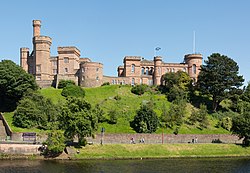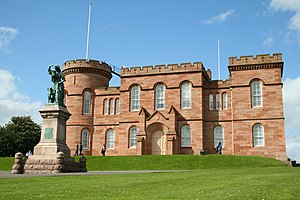Inverness Castle: Difference between revisions
Created page with "{{Infobox castle |name=Inverness Castle |county=Inverness-shire |town=Inverness |picture=Inverness Castle, Scotland - Diliff.jpg |picture caption=Inverness Castle |os grid ref..." |
No edit summary |
||
| Line 2: | Line 2: | ||
|name=Inverness Castle | |name=Inverness Castle | ||
|county=Inverness-shire | |county=Inverness-shire | ||
| | |city=Inverness | ||
|picture=Inverness Castle, Scotland - Diliff.jpg | |picture=Inverness Castle, Scotland - Diliff.jpg | ||
|picture caption=Inverness Castle | |picture caption=Inverness Castle | ||
Latest revision as of 16:09, 10 July 2017
| Inverness Castle | |
|
Inverness-shire | |
|---|---|
 Inverness Castle | |
| Location | |
| Grid reference: | NH666451 |
| Location: | 57°28’35"N, 4°13’32"W |
| City: | Inverness |
| History | |
| Built 1836 | |
| Information | |
Inverness Castle stands on a cliff overlooking the River Ness, in Inverness, the county town of Inverness-shire.
The castle of today, a bold edifice in red sandstone, was built in 1836 by the architect William Burn, but it is built on the site of an 11th-century defensive castle. Today, it houses Inverness Sheriff Court.
The castle itself is not currently open to the public, however a recent campaign has led to the creation of a working group to explore the possibility of doing so in the future.[1] At present, only the castle grounds are open to the public.
History
Early history

A succession of castles has stood on this site since 1057. The castle is said to have been built by King Malcolm III, after he had razed to the ground the castle in which King Macbeth, according to much later tradition, murdered Malcolm's father, King Duncan I: Macbeth's castle stood on a hill around half a mile to the north-east.
Malcolm's Inverness Castle was partially destroyed by King Robert I of Scotland. A replacement castle was sacked in the 15th century by the Clan Donald during the Siege of Inverness (1429). The castle was occupied during the Raid on Ross in 1491.
Mary, Queen of Scots

In 1548 another castle with tower was completed by George Gordon, 4th Earl of Huntly (1514–1562). He was constable of the castle until 1562. The castle was later taken by the Clan Munro and Clan Fraser who supported Mary Queen of Scots during the Siege of Inverness (1562). Robert Mor Munro, 15th Baron of Foulis, chief of the Clan Munro was a staunch supporter and faithful friend of Mary Queen of Scots and he consequently was treated favourably by her son, King James VI.
George Buchanan states, that Mary went to Inverness in 1562 and found the gates of the castle shut against her; "as soon as they heard of their sovereign's danger, a great number of the most eminent Scots poured in around her, especially the Frasers and Munros, who were esteemed the most valiant of the clans inhabiting those countries in the north". These two clans took Inverness Castle for the Queen, which had refused her admission. The Queen later hanged the governor, a Gordon who had refused entry.[2]
George Buchanan's original writings state:[3]
| “ | Audito Principis periculo magna Priscorun Scotorum multitudo partim excita partim sua spoute afferit, imprimis Fraserie et Munoroii hominum fortissimorum in illis gentibus familiae. | ” |
Which translates in English as:
| “ | That as soon as they heard of their Sovereign's danger a great number of the ancient Scots poured in around her, especially the Frasers and Munros, which were esteemed the most valiant families inhabiting those countries. | ” |
Other sieges of Inverness Castle
There were later sieges of Inverness in 1562, 1649, 1650, 1689, 1715 and 1746.
Reconstruction
The current Inverness Castle was built in 1836 on the site of the original one. To improve the more recent castle, a gas, light, and water system was installed.
Outside links
| ("Wikimedia Commons" has material about Inverness Castle) |
- Inverness Castle on CastleUK
- History of Inverness Castle at Am Balie
- Inverness Castle on Castle.org
- Panoramic virtual tour of castle, gardens & view
References
- ↑ "Inverness Castle's tourism potential to be explored". BBC. 15 August 2014. http://www.bbc.co.uk/news/uk-scotland-highlands-islands-28770969. Retrieved 15 August 2014.
- ↑ Clan MUNRO
- ↑ George Buchanan's (1506–1582), History of Scotland, completed in 1579, first published in 1582.
